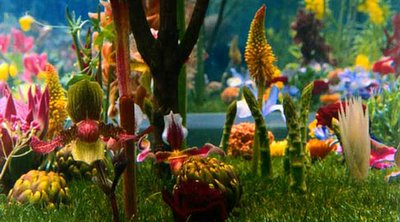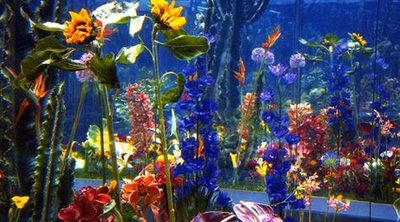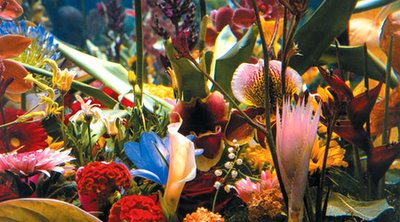
Pruned has been posting some great things lately, but yesterday’s feature just blew me away: it’s a tropical garden by artist Marc Quinn, whose flowers “are immersed in twenty-five tons of liquid silicon kept at a constant temperature of -80˚ Celsius.” (Though that should read silicone – the same material used in breast implants…)

The silicone has the effect of freezing time: the flowers, though dead, will never decay. (Till someone turns the refrigerator off).
They’ve been mummified. An entire landscape has been mummified.

As Quinn himself explains, using all lowercase and some interesting punctuation: “those who visited the installation found themselves, thanks to mirrors, in a garden of infinite beauty and immortality. an enviroment created by plants from various continents -asia, africa-europe- and from different seasons, beauty that doesn’t decay. a perfect image beyond botany itself. these flowers will last forever, but obviously they are dead. the installation in a 3,20 m x 12,70 m x 5,43 m stainless steel refrigerator (-20°C) is technically made of flowers frozen in a silicon oil. (which stays liquid to – 80°C and doesn’t chemically react with the flowers)”

The landscape has been embalmed.
The mind reels.
Could you embalm a riverbed, for instance, to freeze that hydrology in place, its weeds, and erosion, its gravel? Or – here’s the thing: could you go round embalming natural plantlife everywhere – say a developer is encroaching upon some (relatively) untouched hills in the Cotswolds, but here you come, carrying your silicon-embalming tools, hitching up your trousers, and you freeze 5’x5’x5′ cubes of the natural landscape. In place.
Museums of the remnant landscape.
Once all the houses are finally built and everyone moves in, kids find themselves playing beside cubes of mummified plantlife. Garden cubes. Landscape fossils. Embalmed landscapes.
Silicon gardens.
(The trick would be to do this for millions and millions of years, like a landscape time-capsule: here, for instance, outside the BLDGBLOG head office, would be small Jurassic shrubs frozen in liquid silicon; in the middle of the Sahara you’d find tropical orchids, locked in cubes, older than the Himalayas – remnant landscapes preserved…)
Well, I guess the ancient egyptians got into this wat back when.
Only they used honey instead of sub-zero silicon.
Now, if you could trap a couple of flowers in some sub-zero honey, then that would prove an ethical conundrum – preserved in the product of its own fertility…
Could you embalm a riverbed, for instance, to freeze that hydrology in place, its weeds, and erosion, its gravel?
No.
What we do is take experiential transects. We reconceptualise the river. Like whatsisname did there with the cryogarden. And what good would that be? Why not just preserve them in amber? That’ll last a bifillion years, and it won’t require the technology…
But if you’re after technology-intensive solutions for relict landscapes (as invented by, oh someone)
Oh, and it’s Cotswolds. I know Chicagoland is relatively featureless, having civilised its terrain some 150 years ago, and that there’s nothing like the Cotswolds there, but there’s this, this, this, and this to provide landscape relief. Plus, the Cotswolds is not so different from Spring Green and the limestone outcrops of Wildcat Mtn.
But I digress. I always digress. In line with what Andrew MacCorkindale once said, digression is its own reward.
Preservation of relict landscapes is never a clear cut case of preserving a pure sample of a thing. Conversely, it’s always a kluge, a cobbled-together set of elements that reflect a) current tastes and b) extant materials. So, instead of a garden of cut-glass flowers, how about a cross-section of nuclear power plant, chemical refinery, municipal waste processing, and primary education facilities? Or, in a hybrid of technology and old-fashioned natural forces, we could go for some other, totally far-out cryogenic landscapes.
Yes you could: dry the riverbed out, surround a section of it with bulletproof glass walls, slip an impermeable mat of geotextiles several feet beneath it so the silicon can’t drain, then wham! Dump in the refrigerated silicon and you’ve got a preserved hydrologic landscape… For that matter you could use liquid glass, or even resin. Landscapes locked in resin. Or, yes, amber. Riverbeds flowing with amber. Nice link, btw, to cryogenic landscapes…
And, yes, you could use honey: attack of the offspring. Return of the repressed. A new cycle of Greek tragedies, as performed by honey-drenched flowers…
For now, I just want to congratulate your amazing blog. And I’m coming back asap to read it properly 🙂 wx